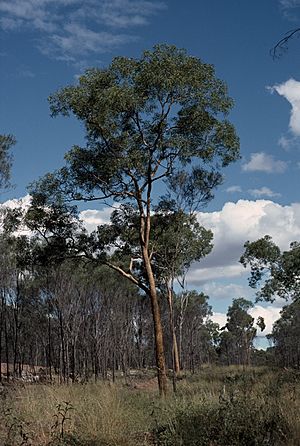Corymbia aureola facts for kids
Quick facts for kids Yellowjacket |
|
|---|---|
 |
|
| Scientific classification | |
| Genus: |
Corymbia
|
| Species: |
aureola
|
| Synonyms | |
|
Eucalyptus aureola Brooker & A.R.Bean |
|
The Yellowjacket tree, also known as Corymbia aureola or yellow bloodwood, is a special type of tree found only in Queensland, Australia. When we say it's "endemic" to Queensland, it means it naturally grows there and nowhere else in the world. This tree has rough bark on its trunk and bigger branches. Its adult leaves are shaped like a spear or slightly curved. Its flower buds grow in groups of seven, and its fruits look like small barrels, urns, or cylinders.
Contents
About the Yellowjacket Tree
The Yellowjacket tree usually grows up to 15 m (49 ft) tall, which is about as high as a four-story building! It has a special woody swelling at its base called a lignotuber. This helps the tree regrow if it gets damaged, for example, by a bushfire. The bark on its main trunk and larger branches is rough and flaky, almost like a puzzle. But on the thinner branches, the bark is smooth and has a yellowish-grey color.
What Does It Look Like?
Young Yellowjacket trees and new shoots (called coppice regrowth) have shiny green leaves. These leaves can be egg-shaped, spear-shaped, or heart-shaped, and they are paler on the underside. They can be quite large, from 110 mm (4.3 in) to 280 mm (11 in) long and 40 mm (1.6 in) to 100 mm (3.9 in) wide.
As the tree gets older, its adult leaves are shiny green on both sides. They are shaped like a spear or are slightly curved, measuring 100 mm (3.9 in) to 205 mm (8.1 in) long and 12 mm (0.47 in) to 30 mm (1.2 in) wide. These leaves grow on a stalk called a petiole, which is 11 mm (0.43 in) to 30 mm (1.2 in) long.
The tree's flower buds grow at the ends of its small branches. They are arranged on a main stalk called a peduncle, which is 8 mm (0.31 in) to 26 mm (1.0 in) long. Each main stalk has seven buds, and each bud sits on a tiny stem called a pedicel, up to 4 mm (0.16 in) long. When the buds are ready, they are oval-shaped, about 8 mm (0.31 in) to 9 mm (0.35 in) long and 7 mm (0.28 in) wide. They have a flattened cap, called an operculum, with a small bump in the middle.
After the flowers, the tree produces woody fruits. These fruits are like capsules and can be shaped like a barrel, an urn, or a cylinder. They are 10 mm (0.39 in) to 17 mm (0.67 in) long and 9 mm (0.35 in) to 16 mm (0.63 in) wide. The parts that open to release the seeds are hidden inside the fruit.
How It Got Its Name
The Yellowjacket tree was first officially described in 1991 by two scientists, Ian Brooker and Anthony Bean. They called it Eucalyptus aureola at that time. They found the tree west of Lake Elphinstone in 1989.
Later, in 1995, two other botanists, Ken Hill and Lawrie Johnson, changed its name to Corymbia aureola. The second part of its scientific name, aureola, comes from a Latin word that means "golden." This name was chosen because of the golden color of the tree's bark.
Where Does It Grow?
The Yellowjacket tree likes to grow in thin, rocky soils on sandstone ridges. You can often find it growing alongside other trees like Acacia shirleyi, Eucalyptus trachyphloia, and Eucalyptus papuana.
This tree is only found in a few specific places in central Queensland. These include the Cherwell Range south of Moranbah, the Carborough Range west of Nebo, and the Yellowjacket Ridge near Blackwater.
Is It Safe?
Good news! The Yellowjacket tree is not considered to be in danger. The Queensland Government has classified it as "least concern" under their Nature Conservation Act 1992. This means there are plenty of these trees around, and they are not currently at risk of disappearing.
See Also
- List of Corymbia species

